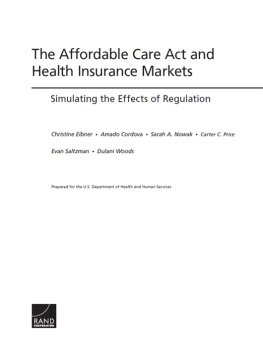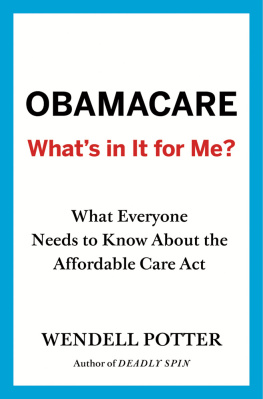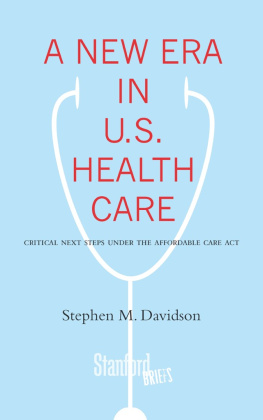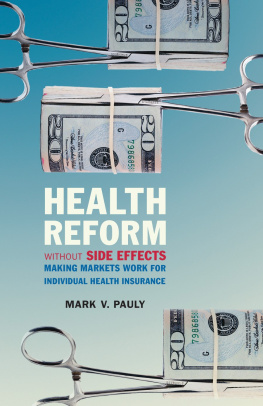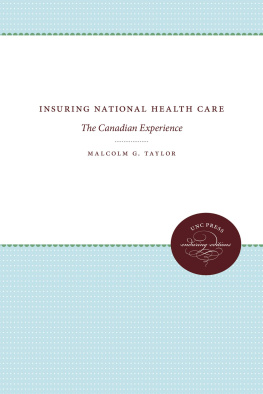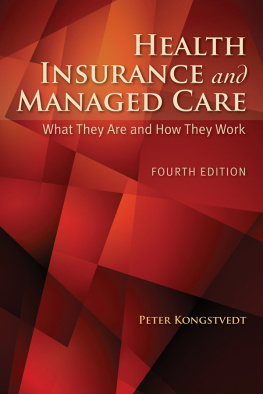The Affordable Care Act and Health Insurance Markets

Simulating the Effects of Regulation
Christine Eibner Amado Cordova Sarah A. Nowak Carter C. Price Evan Saltzman Dulani Woods
Prepared for the U.S. Department of Health and Human Services

The research described in this report was sponsored by the U.S. Department of Health and Human Services. The work was conducted in RAND Health, a division of the RAND Corporation.
eISBN: 9780833081247
The RAND Corporation is a nonprofit institution that helps improve policy and decisionmaking through research and analysis. RANDs publications do not necessarily reflect the opinions of its research clients and sponsors.
Support RANDmake a tax-deductible charitable contribution at www.rand.org/giving/contribute.html
RAND is a registered trademark.
Copyright 2013 RAND Corporation
This document and trademark(s) contained herein are protected by law. This representation of RAND intellectual property is provided for noncommercial use only. Unauthorized posting of RAND documents to a non-RAND website is prohibited. RAND documents are protected under copyright law. Permission is given to duplicate this document for personal use only, as long as it is unaltered and complete. Permission is required from RAND to reproduce, or reuse in another form, any of our research documents for commercial use. For information on reprint and linking permissions, please see the RAND permissions page (http://www.rand.org/pubs/permissions.html).
RAND OFFICES
SANTA MONICA, CA WASHINGTON, DC
PITTSBURGH, PA NEW ORLEANS, LA JACKSON, MS BOSTON, MA
DOHA, QA CAMBRIDGE, UK BRUSSELS, BE
Preface

The Affordable Care Act changes the rating regulations governing the nongroup and small group markets while simultaneously encouraging enrollment through a combination of subsidies, tax credits, and tax penalties. Policymakers and other stakeholders are interested in understanding how these changes might affect health insurance enrollment, premiums, and other outcomes to inform exchange implementation and planning. In this report, we estimate the effects of the Affordable Care Act on health insurance enrollment and premiums for ten states (Florida, Kansas, Louisiana, Minnesota, New Mexico, North Dakota, Ohio, Pennsylvania, South Carolina, and Texas) and for the nation overall, with a focus on outcomes in the nongroup and small group markets. This analysis was sponsored by the Center for Consumer Information and Insurance Oversight (CCIIO, a division of the Centers for Medicare & Medicaid Services [CMS]) through an interagency agreement with the U.S. Department of Health and Human Services (HHS), Assistant Secretary for Planning and Evaluation (ASPE). However, the views, opinions, and findings presented here are those of the authors and should not be construed as official government positions unless so designated by other documents.
The research was conducted by RAND Health, a division of the RAND Corporation. Questions may be addressed to Christine Eibner (.
Summary

The Patient Protection and Affordable Care Act as modified by the Health Care and Education Reconciliation Act of 2010, collectively known as the Affordable Care Act, makes sweeping changes to the regulation of health insurance markets in the United States.
Specifically, the Affordable Care Act requires insurers in the nongroup and small group markets, including those offering coverage in the new state-level health insurance exchanges, to issue and renew policies to everyone who seeks coverage, regardless of health status. In addition, the Affordable Care Act limits insurers ability to charge different prices based on individual characteristics. Insurers can vary prices based only on a few factors:
(1) age
(2) tobacco use
(3) geographic location
(4) family size
(5) the actuarial value of the plan.
For these factors, only a certain amount of variation is allowed:
The oldest adult in the risk pool cannot be charged more than three times as much as the youngest adult. This requirement is known as 3-to-1 rate-banding.
In addition, smokers can be charged no more than 1.5 times more than nonsmokers (1.5-to-1 rate-banding).
These changes raise concerns that the Affordable Care Act could lead to substantial increases in premiums, especially in the nongroup market. For example, commentary in the Wall Street Journal published earlier this year suggested that premiums in some markets could double (Matthews and Litow, 2013). Large increases in premiums might occur because of requirements that health insurance be made available to all comers, regardless of health status, and that insurers cannot charge higher premiums based on such characteristics as health status or previous claims experience. Without other changes, these provisions could lead to adverse selection, in which only people with high expected expenditures enroll.
To address these concerns, the Affordable Care Act contains several provisions intended to increase the chances that younger, healthier individuals will get coverage. First, the act requires that all adults obtain a specified minimum level of coverage or pay a tax penalty. Second, the act offers tax credits that individuals with incomes between 100 and 400 percent of the federal poverty level (FPL) can use to buy coverage if they lack access through other sources, such as an employer or Medicaid. Other provisions, such as reinsurance and requirements that insurers limit the amount of premium revenue spent on non-claims costs, could also reduce premiums relative to what would be expected without the law, potentially making insurance more attractive for younger, healthier enrollees.
The changes, coupled with other policies introduced by the Affordable Care Act, are likely to affect enrollment, premiums, and the composition of the population enrolled in nongroup and small group plans. It is important for federal and state policymakers to understand the potential effects of these changes as they make decisions about setting up the health insurance exchanges.
In this report, we use RANDs Comprehensive Assessment of Reform Efforts (COMPARE) microsimulation model to examine these effects. Specifically, our analysis examines the likely effects of the Affordable Care Act on
the number of uninsured individuals
the number of enrollees in the nongroup and small group markets
the cost of premiums
the characteristics of enrollees.
We also consider the implications of two decisions confronting states: whether to expand their Medicaid programs to cover all adults with incomes below 138 percent of the FPL and whether to merge or combine their small group and nongroup risk pools. If risk pools are merged, enrollees in the small group and nongroup markets would face the same premiums for comparable coverage. If risk pools are split, premiums in the two markets could diverge. For ten representative states (Florida, Kansas, Louisiana, Minnesota, New Mexico, North Dakota, Ohio, Pennsylvania, South Carolina, and Texas), we estimate enrollment and premiums both with and without the Affordable Care Act. Then, for a subset of states, we conduct sensitivity analyses related to these critical state decisions.

